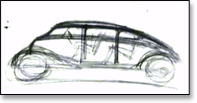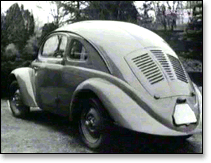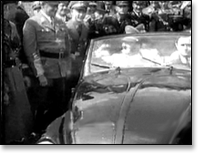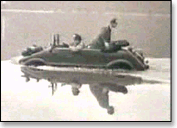HISTORY OF THE BEETLE
|
|
|
Hitlers original design sketch |
The history of the Beetle really goes back to pre 2nd world war Germany when
Ferdinand Porsche had a vision of a mass produced vehicle that was affordable
to the average German, an idea that was shared with the young Adolf Hitler who
himself could not drive, but was a car fanatic. Hitler was apparently
influenced by the achievements of Henry Ford and his production lines - reading
Ford's biography while in prison during 1923. Porsche had previously worked on
some other small cars that used many elements later to be included in the
Beetle. The Type 32 prototype NSU of 1934 was an air-cooled rear engined four
cylinder horizontally opposed powered car that used torsion bar suspension and
featured beetle-like styling.
Hitler became chancellor
in February 1933 and declared at the Berlin auto show his intentions to get
Germany motoring. Read
about Big Business and the Third Reich
Then a year later
at the 1934 show he stated that his government would support the development
of a 'peoples car'. Impressed by Porsche's design capabilities, Hitler delivered
him the design brief of a car that could carry two adults and three children
at a speed of 60mph with at least 33 mpg. The price was to be 1000 Reichmarks,
not much more than a motorcycle at the time. Ferdinand Porsche was not convinced
that a car could be made so cheaply, but considered the project a challenge,
and took it on. The project car was named the Type 60, and due to time constraints
Porsche based many components on the earlier NSU. The engine was an air-cooled
flat-four also based on the NSU design.
|
|
|
Early Prototype |
By late 1935 the first
prototypes were on the autobahns, the V1 saloon and a convertible V2, these
cars had aluminium bodies mounted over traditional wooden frameworks. In 1936
steel bodies mounted over all-steel floorpans were used, powered by a 984cc,
22bhp engine that could reach a top speed of around 65 mph. Another 30
prototypes were then made by Daimler-Benz who were not keen to make such a
cheap car as they thought it would damage their high-class reputation. The
development program was then transferred to the Nazi German Labour Front who
would use German workers contributions to pay for a new factory. The
Daimler-Benz built cars were tested at an SS barracks near Stuttgart and driven
in shifts by 200 soldiers, until any minor problems were corrected. During this
time Dr. Porsche visited the US to view some of the production methods used
there, and recruited some German immigrant engineers who had worked in these
factories.
In 1937, the
coachbuilders Reutter, based in Stuttgart, were asked to make 30 vehicles which
would eventually be shipped to various festivals and fairs to entice the German
public to buy. There were Saloons, sunroofs and convertible models. Hitler also
introduced a savings scheme where the public could collect stamps that would
eventually pay for the car.
|
|
|
Hitler at KDF-Stadt |
On the 26 May 1938,
Hitler ceremoniously laid the cornerstone of the new factory, a huge event
witnessed by an estimated 70,000 people and 150 reporters, all controlled by
the Nazi propaganda machine. It was here that Hitler declared that the model
would be known as the 'KdF-Wagen' or 'Strength through joy' wagen and the
surrounding town that was built to support the factory would be known as the
'KdF-Stadt', production was to start in September 1939 - this turned out to be
the same month that World War Two was declared, and none of the thousands who
had collected their stamps ever received their beetle.
|
|
|
Porsche in Schwimmwagen |
As the War gathered pace,
the KdF-Wagen was put on hold and production changed to military vehicles. The
'Kubelwagen' used the tried and tested and very successful chassis and
air-cooled engine developed for the peoples car. In 1942 the Kubelwagen was joined
by the Schwimmwagen - a four wheel drive vehicle capable of driving on land and
in water. By 1943 over 12,000 prisoners of war were working at the factory,
which was by now mostly repairing aircraft.
For most of the war, the
KdF plant had managed to escape heavy bombing, the new town was not on many
allied maps. Near the end of the war the factory was used to manufacture the V1
'buzz bomb'. This bomb was an unmanned rocket that had the ability to reach
Britain from Germany, and the factory became a main target for the allied
bombing raids. An estimated 2000 V1 bombs hit London before several daylight
bombing raids by the US left the factory in ruins.
The second world war
eventually came to an end and Hitler committed suicide in 1945, the task was
then to rebuild Germany. The Country was devided into quarters, and as the KdF
factory was located in the British section it fell under control of the
British, and Major Ivan Hirst was brought in to assess the possibility of
starting up production of the Beetle as transport for the occupying forces. The
KdF-stadt was renamed Wolfsburg - taking its name from a nearby castle and the
KdF plant was known as the 'Wolfsburg Motor Works'.
Much of the machinery had
survived the bombing having been stored in the basement. Cars were put together
with old-stock and whatever could be found, many using parts from the
Kubelwagen until 1946 when the factory was producing about 1000 cars a month.
Two of the most significant 'special' cars developed while under the control of
the British where the 'Radclyffe Roadster' and a four seater convertible, both
custom built by Rudolph Ringel. The Radclyffe was a two seater roadster that
was the transport of Colonel Charles Radclyffe over the summer months of 1946.
The four seater convertible was Ivan Hirst's personal transport.
In 1948, after the
appointment of Heinz Nordhoff as the VW factory General Director, it was
decided that the Volkswagen range needed to be expanded, and the go-ahead was
given to two factories to produce prototype convertible versions of the Beetle.
Karmann were asked to build a four seater, and Hebmüller were asked to make a
two seater roadster. The design of the roadster was not unlike the 'Radclyffe
Roadster', with similar hood and side windows, the rear engine cover however
was a hand formed panel and not a converted front bonnet as was the Radclyffe
version.
Strength problems were
soon apparent and were solved with sill strengtheners, cross braces, extra
panels, and a flattened off windscreen top, but whereas Karmann relocated the
semaphores to the rear quarter, the Hebmüller's remained in the front quarter.
The prototypes were thoroughly tested and given final approval by Volkswagen,
and the Karosseries were given an order for 2000 cars, with the official
designation of the Hebmuller as Type 14A, and the Karmann the Type 15A.
By the end of 1949, 358
two seater convertibles had been made - comparable to the 364 four seater
convertibles made by Karmann. However, the Hebmüller factory was to hit a major
setback on Saturday, 23rd July 1949. Fire broke out in the paint shop, and
quickly spread throughout the factory. The damage was extensive but with the
help of the employees, the factory was again in production only four weeks
later.
The fire had put a
tremendous strain on the finances of the karosserie and production of the
Hebmüller convertible slowed, with 319 cars made in 1950 (Karmann made 2679).
The coachbuilder finally went out of business in 1952 and production of the
Type 14A was transferred to the Karmann Factory to use up the remaining
Hebmüller parts, the last car built in February 1953.
Volkswagen claims 696
Hebmüllers were sold, although Hebmüller claim that a figure closer to 750 cars
were built. There are surviving cars with body numbers over 700, with the highest
known being 710, but an exact figure of how many cars were built will probably
never be known.
The Wolfsburg factory
continued to build saloons until it was eventually discontinued in 1978, the
biggest change being in 1971 with the introduction of the 'Super Beetle'. These
beetles came equipped with the IRS previously only available on US models, and
an all new MacPherson strut front suspension to replace Porsches preferred
torsion bars. This new front suspension allowed a repositioning of the fuel tank
and spare tire thus giving an increased luggage capacity. The 1302S super
beetle had a slightly redesigned 1600cc engine that developed 50bhp. These
changes were accompanied with a revised external body and a new floorpan.
On the 17th February, 1972, the beetle finally overtook Fords model 'T' as the most popular car ever made, later disputed by Ford who found new production figures, the beetle went on to make sure there was absolutely no doubt. The last beetle to be made in Germany left the production line in January 1978, bringing the end of an era. This was not the end of the beetle though, production continued in Puebla, Mexico in a factory that was built in 1954. The 20,000,000th beetle rolled off the Mexican production line in May 1981 and with demand in Europe for the beetle still high, Volkswagen of Germany was importing beetles from Mexico up to 1985.
Want More? Read about Big Business and the Third Reich
[ THATMETALBOX HOME] [ MY VW INFO HOME] [ VOLKSWAGEN HOME] [ GOOGLE SEARCH]
| taken from:|:-> http://www.pre67vw.co.uk/history/
<-:|:morf nekat |



